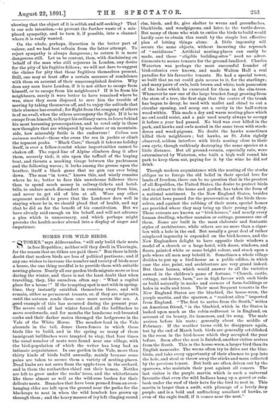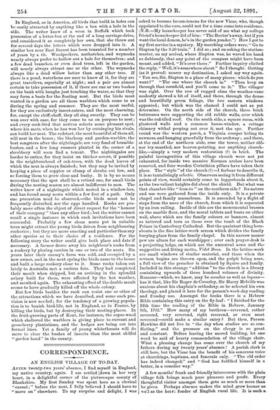HOMES FOR WILD BIRDS.
Q TORKS," says Aldrovandus, " will only build their nests
kl in free Republics; neither will they dwell in Thuringia, .for the reason that no tithes are paid there." But there is little -doubt that modern birds are less of political partisans ; and if any one wishes to increase the number and variety of birds near a house, the one thing needful is to provide them with suitable nesting-places. Nearly all our garden birds migrate more or less during the winter, and there is not the least doubt that when travelling, they, like ourselves, often say : " What a capital place for a house !" If the tempting spot is met with in spring- time, they instantly establish themselves there, and will remain, either as permanent tenants, or, if they are migrants, until the autumn sends them once more across the sea. A good example of this has occurred during the present year. The severe cold of last winter forced all the bullfinches to move southwards, and for months the handsome red-breasted .cocks and their darker mates thronged the hedgerows in the Vale of the White Horse. The meadow-land in the Vale abounds in the tall, dense thorn-fences in which these :birds like to build, and in the spring so many of these immigrant bullfinches were tempted to stay, that four times the usual number of nests were found near one village, with the bird-population of which the writer has long had an intimate acquaintance. In one garden in the Vale, more than thirty kinds of birds build annually, mainly because some pains are taken to secure them a variety of nesting-places. Dead limbs are not sawn from the apple-trees in the orchard, and in them the nuthatches chisel out their homes. Nettles are left to grow under the rooks' trees, and the whitethroats like these almost as well as the wild-rose bushes for their -delicate nests. Branches that have been pruned from an over- hanging elder are left upon the ground near the paths for the blackcaps to nest in when the wild hemlock has grown up 'through them ; and the heavy masses of ivy left clinging round
elm, birch, and fir, give shelter to wrens and greenfinches, blackbirds, and woodpigeons, and later, to the turtle-doves. But many of those who wish to entice the birds to build would hardly care to obtain this result by the simple but effective plan of letting things alone. A little ingenuity will secure the same objects, without incurring the reproach of " untidiness." Artificial nesting-places can easily be made, and these " eligible building-sites " need no adver- tisements to secure tenants for the ground-landlord. Charles Waterton was perhaps the most successful founder of bird-colonies ever known, and made Walton Hall a real paradise for his favourite tenants. He had a special tower, so built that no rat could gain access to it, for the starlings ; and many pairs of owls, both brown and white, took possession of the holes which he excavated for them in the elm-trees. Whenever he saw one of the large bracket fungi growing from the stem of a tree, the first sign that the centre of the trunk has begun to decay, he used with mallet and chisel to cat a circular opening, and scoop out a cavity in the half-rotten wood within. This made a dry and warm nesting-place which no owl could resist, and a pair used nearly always to occupy it before a year had passed. No bird was ever killed in the park, and hawks and owls nested in the same trees with stock- doves and wood-pigeons. No doubt the hawks sometimes killed their neighbours ; but hawks, as St. John rightly observed, seldom interfere with birds nesting close to their own eyrie, though ruthlessly destroying the same species at a, little distance. But all ground-vermin, especially rats, were exterminated by Waterton, who built a high wall round his park to keep them out, paying for it by the wine he did not drink.
Though modern acquaintance with the nesting of the storks obliges us to forego the old belief in their special love for lands of freedom, there can be no question that in the greatest of all Republics, the United States, the desire to protect birds and to attract to the home and garden, has taken the form of a national sentiment. In the New England States, besides the strict laws passed for the preservation of the birds them- selves, and against the robbing of their nests, special homes are provided where they may bring up their young in safety. These retreats are known as " bird-houses," and nearly every human dwelling, whether mansion or cottage, possesses one of them. Some are built in the most elaborate and fantastic styles of architecture, while others are no more than a cigar- box with a hole in the end. But usually a great deal of rather misplaced ingenuity is expended on the bird-houses, and the New Englanders delight to have opposite their windows a model of a church or a large hotel, with doors, windows, and floors, painted white or some bright colour, and stuck upon a pole where all men may behold it. Sometimes a whole village decides to put up a bird-house as a public edifice, in which case the size, paint, and architecture are very grand indeed. But these houses, which would answer to all the varieties named in the children's game of fortune, " Church, castle, cottage, oat-house, barn," are in high favour with such birds as build naturally in nooks and corners of farm-buildings or holes in walls and trees. Their most frequent tenants in the New England States are the bluebird, the house-wren, the purple martin, and the sparrow, a " resident alien " imported from England. " The first to arrive from the South," writes an American friend, " is the bluebird, which in the States is looked upon much as the robin-redbreast is in England, on account of its beauty, its tameness, and its song. The male arrives before his mate ; generally about the middle of February. If the weather turns cold, he disappears again, but by the end of March both birds are generally estr.blished in the room in the bird-house which they occupied the year before. Soon after the nest is finished, another visitor arrives from the South. This is the house-wren, a larger bird than its English namesake. The wrens often try to drive out the blue- birds, and take every opportunity of their absence to pop into the bole, and steal or throw away the sticks and moss collected by the previous tenant. But both are often driven out by the sparrows, who maintain their post against all comers. The last visitor is the purple martin, which is such a universal favourite that even the wild Indians hang up a gourd or cala- bash under the roof of their huts for the bird to nest in. This martin is larger than a swift, with plumage of a lovely deep purple, and is a bold and unflinching assailant of hawks, or even of the eagle itself, if it comes near the nest." In England, as in America, all birds that build in holes can be easily attracted by anything like a box with a hole in the side. The writer knew of a wren in Suffolk which took possession of a letter-box at the end of a long carriage-drive, and considered it so completely her own, that she threw out for several days the letters which were dropped into it. A similar box near East Barnet has been tenanted for a number of years by a tit. Woodpeckers, nuthatches, and wrynecks nearly always prefer to hollow out a hole for themselves ; and a few dead branches, or even dead trees, left in the garden, will nearly always attract one or the other. The wrynecks always like a dead willow better than any other tree. If there is a pond, waterhens are sure to know of it, for they are great travellers, especially at night ; and a pair are almost certain to take possession of it, if there are one or two bushes on the bank with boughs just touching the water, so that they may form a basis for the floating nest. But the birds most wanted in a garden are all those warblers which come to us during the spring and summer. They are the most useful, for they are exclusively insect-eaters, and the most charming, for, except the chill-chaff, they all sing sweetly. They can be won over with ease, for they come to us on purpose to nest ; and every cock-bird that arrives selects some pleasant spot, where his mate, when he has won her by outsinging his rivals, can build her nest. The redstart, the most beautiful of them all, will nest in the boxes ; the blackcap and garden-warbler, the best songsters after the nightingale, are very fond of bramble- bashes, and a few long runners planted in the corner of a shrubbery will soon find a tenant. The nightingales are harder to entice, for they insist on thicker covert, if possible in the neighbourhood of oak-trees, with the dead leaves of which the nest is always finished ; but they may be invited by keeping a piece of coppice or clump of shrubs cut low, and so forcing them to grow close and bushy. It is by no means necessary that the spot shall be a retired one, for small birds during the nesting season are almost indifferent to men. The writer knew of a nightingale which nested in a window-box, and has found many nests within a few feet of a path. Only one precaution need be observed,—the birds must not be frequently disturbed, nor the eggs handled. Rooks are pro- bably more often the object of direct request for the "honour of their company " than any other bird ; but the writer cannot recall a single instance in which such invitations have been successful. Probably a few sham nests put in suitable trees might attract the young birds driven from neighbouring rookeries ; but they are more exacting and particular than any other species as to their choice of a residence. For the following story the writer could give both place and date if necessary. A farmer drove away his neighbour's rooks from a rookery by placing carrion in one or two of the nests. Six years later their enemy's farm was sold, and occupied by a new owner, and in the next spring the birds came to the house and built a large rookery close to it. Some rooks taken out lately to Australia met a curious fate. They had completed their moult when shipped, but on arriving in the splendid aviary built for them, were affected by the hot weather, and moulted again. The exhausting effect of the double moult seems to have gradually killed off the whole colony.
But few birds besides the rook can resist one or other of the attractions which we have described, and some such pro- vision is now needed ; for the tendency of a growing popula- tion is to banish bird-life, not in England, as in France, by killing the birds, but by destroying their nesting-places. In the fruit-growing parts of Kent, for instance, the copse-wood which sheltered the warblers is giving place to currant and gooseberry plantations, and the hedges are being cut into formal lines. Yet a family of young whitethroats will do more to clear the bushes of insects than the most skilful "garden hand" in the county.



































 Previous page
Previous page